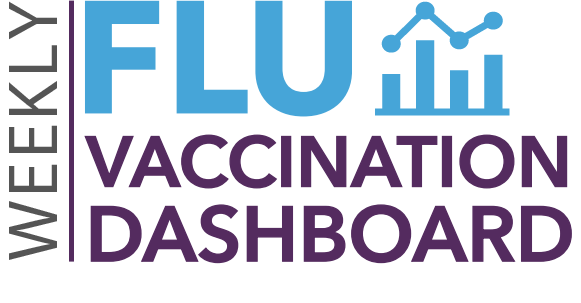About

Data Summary
Data Updates
For the 2025–26 season, as of December 6, 2025, 129.8 million doses of flu vaccine have been distributed in the United States. Data and charts are available.
Flu vaccine supply depends on private manufacturers who produce the vaccine.
Additional information on supply for this and previous seasons are available.
Flu vaccination coverage estimates for children 6 months─17 years are based on data from CDC's National Immunization Survey–Flu (NIS-Flu), which are based on parental report. Data and charts are available.
- As of December 13, 2025, 42.3% (95% Confidence Interval [CI] 39.9%–44.7%) of children received a flu vaccination, similar to last season at this same time point (41.9%).
- 10.4% (8.0%─12.7%) of children had a parent who reported they definitely planned to get their child vaccinated.
- The percentage of children who received a flu vaccination varies by child's age, mother's education, poverty status, race and ethnicity, urbanicity, and jurisdiction.
- CDC's final estimates for previous flu seasons are available.
The summaries for the 2025─26 season will be populated as the data become available throughout the fall/winter.
Flu vaccination coverage estimates among adults 18 years and older are based on data from CDC's National Immunization Survey–Fall Respiratory Virus Module (FRVM), which are based on respondent self-report. Data and charts are available.
- As of December 13, 2025, 42.2% (95% Confidence Interval: 40.9%─43.5%) of adults reported having received a flu vaccination, higher than last season at this same time point (40.5%).
- 7.4% (6.3%─8.4%) reported they definitely will get a vaccine.
- Vaccination coverage varied by age, health insurance status, poverty status, race and ethnicity, urbanicity, sex, and jurisdiction.
- CDC's final estimates for previous flu seasons are available.
Within-season, jurisdiction-level, vaccination coverage estimates for children 6 months–17 years and adults 18 years and older are based on IIS data submitted to CDC through the end of November 2025 by 13 immunization awardee jurisdictions. The coverage of some Pacific Island jurisdictions may reflect vaccination program activities aligned with regional virus circulation patterns (i.e., they may vaccinate on a different schedule than the continental U.S.). Data and charts are available.
- For children 6 months–17 years:
- Among the currently reporting 11 state and city IIS jurisdictions, flu vaccination coverage ranged from 9.9% to 23.3%.
- Among two reporting U.S. territorial and affiliated island jurisdictions, coverage ranged from 4.8% to 15.0%.
- For adults 18 years and older:
- Among the currently reporting 11 state and city IIS jurisdictions, flu vaccination coverage ranged from 15.0% to 25.2%.
- Among two reporting U.S. territorial and affiliated island jurisdictions, coverage ranged from 0.2% to 6.0%.
Flu vaccination coverage among Medicare fee-for-service beneficiaries 65 years and older is assessed using data files from the Medicare Fee-For-Service administrative claims data managed by the Centers for Medicare & Medicaid Services. Data and charts are available.
- As of September 27, 2025, an estimated 12.7% of Medicare fee-for-service beneficiaries 65 years and older were vaccinated.
- Vaccination coverage was highest among non-Hispanic Asian (16.3%) beneficiaries and lowest among Hispanic (7.4%) beneficiaries.
IQVIA measures flu vaccinations administered at retail pharmacies and American Medical Association (AMA) physicians' medical offices for adults 18 years and older, based on healthcare claims data. Data and charts are available, with estimates available overall and by select age groups.
- For the 2025–26 season, as of November 29, 2025:
- An estimated ~31.0 million doses of flu vaccine were administered in retail pharmacies.
- This was ~2.1 million fewer doses than were administered by this same time point in the 2024–25 flu season.
- An estimated ~16.7 million doses were administered in physicians' medical offices.
- This was ~872,822 fewer doses than were administered by this same time point in the 2024–25 flu season.
The Indian Health Service's (IHS) Influenza-like Illness Awareness System (IIAS) captures flu vaccination coverage among American Indian and Alaska Native (AI/AN) patients who received care in an IHS and in some Tribal or Urban Indian (I/T/U) healthcare facilities.
The health care personnel flu vaccine coverage is captured through the IHS National Immunization Reporting System (NIRS) and includes employees who work in IHS and in some tribal and urban healthcare facilities.
There may be gaps in both the IIAS and NIRS systems since not all I/T/U healthcare facilities report.
Data are available via Indian Health Service.
Data & Charts
Data & Charts
- Flu Vaccine Doses Distributed (CDC)
- Child Flu Vaccination Coverage and Intent (NIS-Flu)
- Pregnant Women Flu Vaccination Coverage (VSD)
- Adults 18+ Flu Vaccination Coverage and Intent (NIS-FRVM)
- Monthly Child and Adult Flu Vaccine Administration and Coverage by Jurisdiction (IIS)
- Adults 65+ Medicare fee-for-service Flu Vaccination Coverage (CMS)
- Adults 18+ Flu Vaccinations Administered (IQVIA)
Additional Weekly Influenza Data Resource
- FluView: A U.S. weekly Influenza surveillance report and interactive data
Prevent Flu
- Everyone 6 months and older should get a flu vaccine every season with rare exceptions.
- Vaccination is particularly important for people who are at higher risk of serious complications from influenza.
- You can get a COVID-19 vaccine and a flu vaccine at the same time.
- Download free CDC's seasonal flu vaccination campaign materials.
